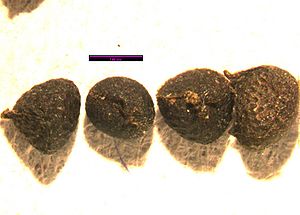Difference between revisions of "Sisyrichium idahoense"
| Line 37: | Line 37: | ||
</gallery> | </gallery> | ||
==References== | ==References== | ||
| + | |||
| + | [[categories:User pages]] | ||
Revision as of 10:49, 16 April 2012
First overview block: Scientific Name, Synonyms, Family, English Names, Other Names
Contents
Taxonomy
- Kingdom: Plantae
- (unranked): Angiosperms
- (unranked): Monocots
- Order: Asparagales
- Family: Iridaceae
- Subfamily: Iridoideae
- Tribe: Sisyrinchieae
- Genus: Sisyrinchium
- Species: S. idahoense
Description
Showy, tufted perennial to 40 cm tall; stems usually flattened and wing-margined. Leaves mostly basal, long (to 20 cm).and very narrow (< 2 mm broad). Flowers blue to purplish-blue often with a yellow "eye", small (about 2 cm across) and in a terminal cluster of one to five flowers above a pair of sheathing, leaf-like bracts. Fruits egg-shaped capsules to 6 mm long, with black seeds (Pojar and MacKinnon, 1994).
Bloom Period
May to July
Distribution
Habitat
Uses
Site Rehabilitation
Possible reclamation species in moister pockets in selected sites (Winters, 2002).
Wildlife
Solitary bees of the family Megachilidae are mainly responsible for cross-pollination in natural populations (Henderson, 1976).
Landscaping
Mass-plant to create a showy display in a border or a rock garden (Tenenbaum et al., 1994).
First Nations
Infusion of root given to children for diarrhea; Eaten as cooked greens for “regular bowels”; decoction of roots and stalks taken before morning meal for constipation; compound with plant taken for “summer complaint”; infusion of plant taken for stomach troubles and stomach worms; mixed with other greens and eaten.
Propagation
Photo Gallery
Links can be put in captions.


